Your home should be your sanctuary, and deadbolt locks are the silent guardians at your doorstep. In this guide, we will discover what is a deadbolt lock. Understand their basics, addressing common issues and vulnerabilities.
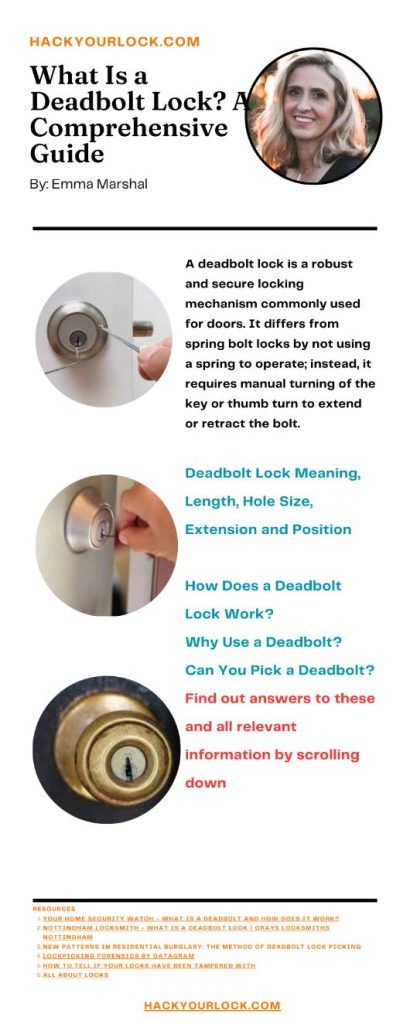
Discover what makes a deadbolt unique, the differences between various types, and why they are essential for fortifying your home’s security. By the end of this journey, you will be equipped with the knowledge to make informed decisions about your home security and ensure your peace of mind.
Contents
- 1 What is Deadbolt Lock?
- 2 How Does a Deadbolt Lock Work?
- 3 Why Use a Deadbolt?
- 4 Can You Pick a Deadbolt?
- 5 Disadvantages of a Deadbolt Lock
- 6 Deadbolt Lock Maintenance
- 7 Is a Deadbolt Lock Safe?
- 8 How to Install Deadbolt Lock
- 9 Conclusion
- 10 FAQ’s
- 11 Resources
What is Deadbolt Lock?
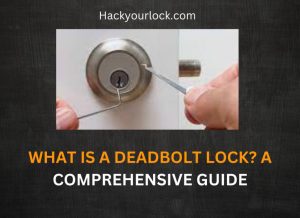
A deadbolt lock is a robust and secure locking mechanism commonly used for doors. It differs from spring bolt locks by not using a spring to operate; instead, it requires manual turning of the key or thumb turn to extend or retract the bolt.
Deadbolt locks provide enhanced security and are integral to home and commercial security systems, offering resistance to forced entry attempts.
Deadbolt Lock Meaning, Length, Hole Size, Extension and Position
A deadbolt lock is a sturdy locking mechanism primarily used for securing doors. It extends into the door frame to prevent unauthorized entry.
- Length: Deadbolt locks typically come in lengths of 1 inch (25.4 mm), 2 inches (50.8 mm), and 2.5 inches (63.5 mm). The length choice depends on the door’s thickness and the level of security required.
- Hole Size: The standard hole size for a deadbolt lock is 2.125 inches (54 mm) in diameter. This hole is drilled through the door to accommodate the lock mechanism.
- Extension: Deadbolts usually have an extension of 1 inch (25.4 mm) or 1.25 inches (31.75 mm). This refers to how far the bolt extends into the door frame when the lock is engaged. The longer the extension, the more secure the lock.
- Position: The ideal position for installing a deadbolt lock is typically 6 to 12 inches (152.4 mm to 304.8 mm) above the doorknob. This placement ensures that the bolt engages securely with the strike plate in the door frame.
What is the difference between a Deadbolt and a Deadlock?

A deadbolt and a deadlock are both secure locking mechanisms, but they differ in their operation and application.
A deadbolt is a type of lock that uses a manual key or thumbturn to extend or retract the bolt, providing enhanced security by resisting forced entry attempts.
It is typically used on exterior doors for homes and commercial buildings(Nottingham Locksmith – What is a Deadbolt Lock | Grays Locksmiths Nottingham)
On the other hand, a deadlock refers to a lock that doesn’t have a spring mechanism and requires a key to lock or unlock it from both the inside and outside.
Deadlocks are often used in situations where maximum security is required, such as in high-security commercial settings.
The key distinction lies in how they can be locked and unlocked; a deadbolt can be locked from the inside without a key, while a deadlock requires a key for both sides.
Why You Need a Deadlock?
You need a deadlock for maximum security because it requires a key to lock or unlock it from both the inside and outside, making it nearly impossible for intruders to gain unauthorized access.
How Does a Deadbolt Lock Work?
A deadbolt lock utilizes a sturdy metal bolt extending into a doorframe reinforced with a robust metal “strike plate.”
This bolt is commonly referred to as “dead” because it can only be retracted manually, typically via a key, thumb-turn, or electronic means in smart and keyless locks.
When engaged, the bolt creates an immovable barrier, securing the door and preventing unauthorized access. (Your Home Security Watch – What is a Deadbolt and How Does it Work?)
Deadbolts offer enhanced security compared to spring-latch mechanisms in doorknobs since they require manual activation, making them resistant to methods like credit card manipulation or latch slips.
Benefits of Using Deadbolts
The benefits of using a deadbolt are as follows:
Mechanical Activation

Unlike spring-latch mechanisms found in doorknobs, deadbolts necessitate mechanical activation, making them impervious to techniques such as credit card or knife manipulation and professional tools like latch slips.
Deep Bolt Extension
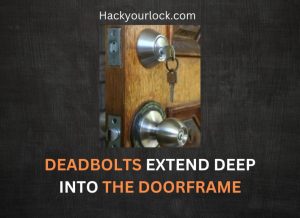
Deadbolts extend deep into the doorframe, enhancing their resistance to forced entry tactics like kick-ins.
User-Friendly
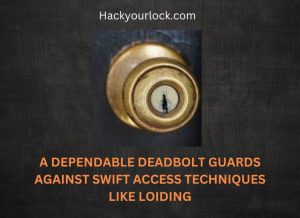
Deadbolts are user-friendly, ensuring they are frequently engaged and providing consistent security.
A dependable deadbolt not only guards against swift access techniques like loiding but also significantly extends the time it takes for an intruder to breach your door.
The Main Parts of a Deadbolt
In a deadbolt lock system, several key components come into play. First and foremost is the bolt, a critical element that extends from the lock into the doorframe.
Bolts come in various materials, sizes, shapes, and lengths, with the quality of your lock determining these characteristics.
The outer trim, located on the exterior side of the door, features a keyed-lock cylinder that allows the bolt to be activated.
Conversely, the inner trim inside your home is typically operated using a thumb turn for easy locking and unlocking.
In some instances, the inner trim may also incorporate a key cylinder, requiring a key for access from both the inside and outside of the door.
These components collectively contribute to the functionality and security of a deadbolt lock.
Deadbolt Types
Deadbolt types with distinct characteristics encompass single-cylinder and double-cylinder, Keyless Deadbolt, Vertical Deadbolt, and Rim Deadbolt.
A single-cylinder deadbolt employs a key on the exterior and a thumb-turn on the interior for easy exit, ideal for most residential applications.
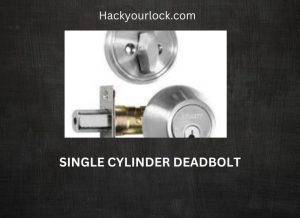
Conversely, a double-cylinder deadbolt requires a key for both sides, enhancing security but necessitating a key for exit as well. Choosing between the two depends on your security needs and preference for convenience.
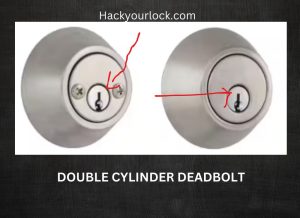
Keyless Deadbolts are electronic locks like keypad locks and smart locks that don’t require traditional keys for entry.
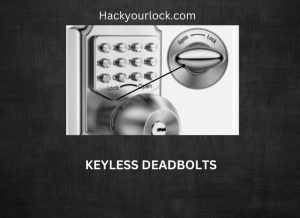
In Vertical Deadbolt, the bolt moves vertically, enhancing security.

The Rim Deadbolt is accessible only from the interior side of the door, providing additional privacy and security.
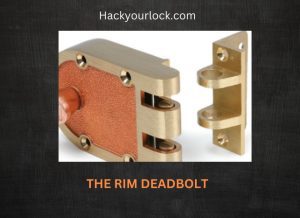
Deadbolt Door Lock Types can consist of any of the above.
Deadbolt Lock Double vs Single Cylinder

Double-cylinder deadbolts require keys for both inside and outside access, while single-cylinder deadbolts only need a key on the outside, offering varying levels of security and convenience.
Deadbolt Lock vs Regular Lock
Deadbolt locks are more secure than regular locks due to their manual operation and bolt extension into the doorframe, providing enhanced resistance against forced entry.
Deadbolt Lock vs Strike Plate
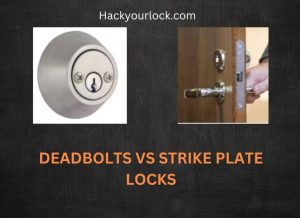
A deadbolt lock is the locking mechanism itself, while a strike plate is the metal plate on the door frame where the bolt engages, reinforcing security.
Deadbolt vs Latch
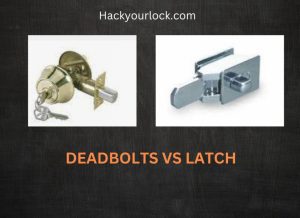
Deadbolts provide superior security compared to latch locks as they require manual activation and extend deep into the doorframe, making them more resistant to forced entry.
Deadbolt vs Dead latch

Deadbolts and dead latches serve distinct purposes; deadbolts offer greater security by requiring keys or thumb-turns to operate, while dead latches are typically used in commercial settings and automatically latch when the door is closed.
Latch Bolt vs Deadbolt
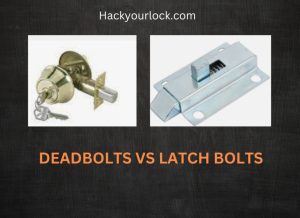
Latch bolts are less secure than deadbolts as they automatically engage when the door is closed but can be easily manipulated, whereas deadbolts require manual activation for enhanced security.
Deadbolt vs. Spring Lock
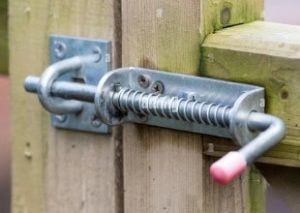
Deadbolts are more secure than spring locks as they require manual operation and extend deeply into the doorframe, making them resilient against forced entry, whereas spring locks can be quickly bypassed.
Why Use a Deadbolt?
Deadbolts are essential for security as they provide superior resistance to forced entry, enhance protection against burglaries, and require manual activation, making them more reliable than regular locks.
Can You Pick a Deadbolt?
Yes, deadbolts can be picked, but it’s challenging and typically requires specialized tools and skills. Locksmiths and individuals with lock-picking skills can manipulate deadbolts using specialized tools and techniques. This includes techniques like using bump keys, snap guns, Lishi picks, and impressioning, which are commonly employed to bypass deadbolt locks.
Picking a deadbolt involves manipulating the lock’s internal components to align them to allow the bolt to retract without a key. Here are some key details:
1. Tools
Lock picking requires specialized tools like lock picks, tension wrenches, and rake picks. These tools are used to manipulate the pins inside the lock.
2. Skill and Knowledge
Lock picking is a skill that requires knowledge of how locks work and an understanding of the specific type of lock being picked.
3. Tensioning
A tension wrench is used to apply rotational force to the lock cylinder, simulating the turning of a key. This tension is essential to keep the lock pins in place while manipulated.
4. Picking Pins
Lock picks are used to manipulate the individual pins inside the lock. By applying upward pressure on the pins while simultaneously rotating the lock cylinder, a skilled locksmith or intruder can align the pins at the shear line, allowing the lock to be turned and opened.
Disadvantages of a Deadbolt Lock
While deadbolt locks offer robust security, they have drawbacks. These can be categorized as deadbolt lock problems as well.
1. Deadbolt Lock Doesn’t Line Up
One common drawback of deadbolt locks is their need to line up correctly with the strike plate.
This misalignment can result from various factors, including door settling, frame shifting, or improper installation.
When the deadbolt doesn’t align properly, it can be challenging to lock or unlock the door smoothly. It’s crucial to address this issue promptly to maintain the security of your entryway.
2. Deadbolt Lock Getting Stuck
Another disadvantage you might encounter with deadbolt locks is the lock getting stuck. Sometimes, you find out that the deadbolt Lock Is Stuck.
Over time, deadbolts can accumulate dust, debris, or experience wear and tear, causing them to jam or become difficult to operate.
Proper maintenance and occasional lubrication can help prevent this issue. Additionally, if the lock consistently gets stuck, it may indicate the need for repairs or replacement.
3. Deadbolt Lock Keeps Spinning
Sometimes, deadbolt locks may exhibit a frustrating behavior where the key or thumb-turn keeps spinning without effectively engaging the lock. Deadbolt Lock Just Spins, and it’s a frustrating situation for you.
This issue can occur due to internal problems within the lock mechanism or wear and tear.
When the lock keeps spinning without securing the door, it becomes unreliable and poses a security risk. Professional assistance may be required to address this problem effectively.
4. Deadbolt Lock Key Won’t Turn
Sometimes deadbolt locks the Key, and the turn feature refuses the execution, making it a frustrating experience for the user. This issue can result from various factors, including a damaged or worn-out key, or issues within the lock itself.
Attempting to force the key can worsen the problem, potentially leading to a lockout situation.
It’s advisable to address this issue promptly by contacting a locksmith or replacing the key and lock components if necessary, as the deadbolt lock is jammed.
5. Deadbolt Lock Won’t Unlock
One of the most critical concerns is when a deadbolt lock won’t unlock. This situation can pose a serious safety hazard, potentially trapping occupants inside during an emergency.
If you are in this predicament, avoid excessive force and contact a professional locksmith immediately.
Identifying and resolving the root cause of the lock malfunction is vital to restoring the lock’s functionality and ensuring your safety and security.
Other Vulnerabilities
- Lock Bumping: Intruders may use specialized bump keys to manipulate the lock, potentially granting unauthorized access.
- Impressioning: This technique involves creating a duplicate key by making an impression of the lock’s pins, which can compromise security.
- Snap Guns: Snap guns are tools that can quickly manipulate certain lock types, presenting a risk to your security.
- Lishi Keys: Skilled locksmiths may use Lishi keys to decode and unlock some locks, posing a potential vulnerability.
- Drilling: Forced entry via drilling the lock core is a common tactic used by burglars to breach security.
- Ice Pick Attack: Intruders might employ an ice pick or similar tool to manipulate lock mechanisms, compromising your security.
- Weak Door or Door Frame: A flimsy door or frame can make it easier for intruders to force their way inside, regardless of the lock’s strength.
- Improper Installation: If a deadbolt is not correctly installed, it can weaken your security, allowing for easier unauthorized access.
Deadbolt Lock Maintenance
Regular maintenance is crucial to ensure the continued reliability of your deadbolt lock.
This includes lubricating the lock mechanism, inspecting for any signs of wear or damage, and tightening loose screws.
Additionally, periodically check the strike plate and door frame for proper alignment.
Is a Deadbolt Lock Safe?
Yes, deadbolt locks are considered safe and fundamental to home security.
They offer enhanced resistance to forced entry attempts compared to standard locks. However, their effectiveness depends on proper installation, quality, and maintenance.
Combining deadbolt locks with other security measures, such as security strike plates and reinforced doors, further enhances safety.
What Is the Most Secure Deadbolt Lock?
The most secure deadbolt lock is typically one that meets or exceeds industry standards for security. Look for deadbolts that are ANSI/BHMA Grade 1 certified, as they offer the highest level of security.
Additionally, consider features like reinforced strike plates, anti-drill pins, and pick-resistant mechanisms.
Brands known for their high-security deadbolt locks include Medeco, Schlage, and Mul-T-Lock. However, ensuring the lock is professionally installed is important to maximize security.
How to Install Deadbolt Lock
Installing a deadbolt lock involves these steps:
- Measure and mark the lock placement.
- Drill holes for the lock and strike plate.
- Install the lock cylinder and bolt.
- Attach the strike plate.
- Test the lock’s operation
Who Installs Deadbolt Locks?
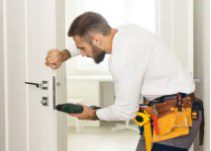
Deadbolt lock installation is typically done by locksmiths or experienced handymen.
Professional installation ensures proper alignment, security, and functionality, enhancing the effectiveness of the lock in protecting your property. Find out All About Locks and who installs them and how.
Conclusion
We have covered everything about what is a deadbolt lock. Deadbolt locks are essential components of home and business security. They provide a robust defense against forced entry and unauthorized access, enhancing safety and peace of mind.
Understanding their types, operations, and potential vulnerabilities is crucial for making informed choices to safeguard your property. Regular maintenance and professional installation further bolster their effectiveness.
Investing in high-quality deadbolt locks and practicing proper security measures can significantly enhance your premises’ protection.
FAQ’s
What Does a Deadbolt Lock Look Like?
A deadbolt lock typically resembles a sturdy, rectangular metal lock with a keyhole and thumb-turn.
What Is a Deadbolt Lock on a Door?
A deadbolt lock on a door is a security device that extends or retracts a bolt to secure or release the door.
What Is a Good Deadbolt Lock?
A good deadbolt lock is one that meets high-security standards and features anti-pick, anti-drill, and anti-bump features.
What Is a One-Sided Deadbolt?
A one-sided deadbolt only operates with a key from the exterior and has no thumb-turn on the interior.
What Is Deadbolt Lock Without Screws?
A deadbolt lock without screws may refer to a keyless or electronic deadbolt that doesn’t require traditional screws for installation.
What Is the Purpose of a Deadbolt?
The purpose of a deadbolt is to provide enhanced security by preventing unauthorized access through doors.
Are Double Keyed Deadbolt Locks Illegal?
Double-keyed deadbolt locks are not illegal but have specific regulations in some areas due to safety concerns.
Are There Different Size Deadbolt Locks?
Yes, different sizes of deadbolt locks, including standard, narrow, and interconnected varieties, fit various door types and applications.
Resources
- Your Home Security Watch – What is a Deadbolt and How Does it Work?
- Nottingham Locksmith – What is a Deadbolt Lock | Grays Locksmiths Nottingham
- New patterns in residential burglary: The method of deadbolt lock picking
- Lockpicking Forensics by Datagram
- How to Tell If Your Locks Have Been Tampered With
- All About Locks
